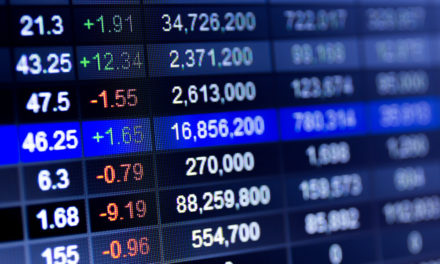Stocks tumbled again as investors became more worried that worsening trade tensions and other factors could further weaken the global economy and more in Wednesday’s Stock Market Update.
The Dow Jones Industrial Average lost almost 500 points Wednesday, its second big drop in a row.
The latest bout of selling followed a report showing hiring by U.S. companies slowed more than expected last month, particularly in mining and manufacturing.
A day earlier, markets were shaken by the weakest reading on U.S. manufacturing growth in a decade.
Adding to the market’s uncertainty was a ruling by the World Trade Organization that cleared the United States to impose tariffs on up to $7.5 billion of goods from the European Union to make up for illegal subsidies given to plane-maker Airbus.
Prices fell across the stock market, accelerating as the day progressed, and all 11 sectors that make up the S&P 500 lost ground from stodgy utilities to go-go technology companies. Nearly five stocks fell for every one that rose on the New York Stock Exchange.
In search of safety, investors piled into U.S. government bonds and sent yields sliding for a second straight day. Gold also rose, while oil sank after a report showed that the amount of crude supplies in inventories swelled last week.
STOCK MARKET UPDATE
KEEPING SCORE: The S&P 500 fell 52 points, or 1.8%, to 2,887. The Dow gave up 494 points, or 1.9%, to 26,078. The Nasdaq fell 123 points, or 1.6%, to 7,785.
Bond prices rose as investors searched for safety. The yield on the 10-year Treasury fell to 1.60%.
SECTORS: Technology stocks were among the biggest losers, led by declines from Microsoft and Apple. The sector has swung sharply with shifts in economic forecasts and President Donald Trump’s trade war with China.
Banks were also laggards as bond yields continued to slide. Lower interest rates can crimp the profits banks make from lending, and the yield on the 10-year Treasury fell to 1.60% from 1.64% late Tuesday.
Citigroup fell 2.7% and Bank of America fell 2%.
Utility stocks also fell, but by less than the rest of the market as the dividends they pay looked more attractive. Utilities in the S&P 500 lost around 1.2%.
OVERSEAS: Stocks in Europe and Asia fell broadly as the global prospects for economic growth dim amid trade uncertainty.
Germany’s DAX lost 2.8%, while the CAC 40 in Paris dropped 3.1% and the FTSE 100 in London lost 3.2%.
Japan’s Nikkei 225 slipped 0.5%, South Korea’s Kospi fell 2% and the Hang Seng in Hong Kong dipped 0.2%.
OCTOBER CHILL? Stocks have gone cold in October as trade worries dampen economic growth prospects.
The S&P 500 is already down 3.1% for the month.
October could turn out to be more volatile than usual after a relatively calm September. Most of the movement in the market was very slight last month, despite that month’s reputation for large swings, said Ryan Detrick, senior market strategist for LPL Financial, in a note.
“This normally volatile month could be passing some big moves to October this year,” he said.
U.S. and Chinese envoys are expected to meet for yet another round of trade talks next week, and markets have been quick to move on any hint of the chances of a possible deal.
WHAT LIES AHEAD: The weaker-than-expected report on private-sector hiring puts more emphasis on Friday’s more comprehensive jobs report from the federal government. Economists expect that to show hiring accelerated last month.
The fear is that weakness in manufacturing around the world will spill over into other areas of the economy. If the U.S. jobs market slows, it would remove support from one of the main pillars propping up the economy: strong spending by households.
Another key indicator due this week is Thursday’s report on the services sector. Services make up the bulk of the U.S. economy and the sector has continued to grow even as manufacturing has slumped.
The weaker-than-expected reports so far this week mean investors are increasing their bets that the Federal Reserve will deeply cut interest rates at its next meeting.
Markets are pricing in a 77.5% probability of a half-point percentage cut at the Fed’s Oct. 29-30 meeting. A week ago, markets were seeing it closer to a coin flip’s chance. The Fed hasn’t cut rates by that large a margin since the financial system was melting down in 2008.
BUILDING PROFIT: Lennar rose 3.8% after the homebuilder soared beyond Wall Street’s third quarter profit forecasts on a healthy increase in home deliveries and revenue. The company also reported a solid increase in new home orders.
DIM RESULTS: Acuity Brands fell 11.1% after the lighting products maker reported weak profit and revenue during its fiscal fourth quarter. The company said it remains cautious on its forecast for 2020 because of the uncertainty around trade disputes and tariffs.
© The Associated Press. All rights reserved.




